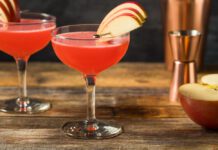This page may contain affiliate links. Please see our Disclaimer for more information. Always drink responsibly and adhere to your local legal drinking age.
Introduction
Cognac, a luxuriously rich and complex spirit, offers a remarkable sensory journey beyond its exquisite taste. Distilled from Ugni Blanc grapes and aged in oak barrels, it is deeply rooted in history, craftsmanship, and emotion.
As you delve into this blog post about the fascinating world of cognac, we invite you to explore how its unique flavors evoke personal associations and emotional responses.
Discover the intricate process behind creating this celebrated liquor and learn how to appreciate better the art of savoring each captivating sip while debunking common misconceptions.
Key Takeaways:
- Cognac is a luxuriously rich and complex spirit that offers a remarkable sensory journey beyond its exquisite taste, rooted in history, craftsmanship, and emotion.
- Understanding the distillation and aging process of cognac involves double-distilling fermented wine to create a clear high-proof spirit aged in oak barrels for at least two years to develop its flavor and complexity.
- The blend of different eaux-de-vie, or grape spirits aged for varying periods along with the oak barrel’s porousness results in subtle interaction fostering unique flavors ranging from spicy to sweet; experts recommend taking time to savor each sips when drinking cognac – appreciating all the various flavors and aromas this drink has without any preconceived notions about what you should expect.
- Beyond just taste enjoyment, cognac’s personal associations and cultural significance can evoke emotional responses through memory formation. Drinking it moderately can positively affect mood regulation as well.
Understanding The Distillation And Aging Process Of Cognac
The distillation process of cognac involves double-distilling the fermented wine to create a clear, high-proof spirit that is then aged in oak barrels to develop its flavor and complexity.
Harvesting And Fermenting Grapes
The magic of exceptional cognac begins with the meticulous harvesting and fermenting of grapes. In the Cognac region of France, vineyards are filled with Ugni Blanc grapes, known for their high acidity and low sugar content – an ideal combination for producing quality wine for distillation.
Following the harvest, these luscious grapes undergo fermentation to transform into low-alcohol wine. This crucial step in cognac production involves using natural yeasts on grape skins, which convert sugars into alcohol, leaving behind unique flavors and aromas characteristic of each vineyard’s terroir.
Double-distillation
Double-distillation is a crucial aspect of the cognac-making process that sets it apart from other spirits. This method involves two rounds of distillation, refining the wine made from Ugni Blanc grapes into a luxurious and flavorful end product.
In the first round, the fermented grape juice is heated in copper Charentais pot stills to create brouillis, a raw eau-de-vie with an alcohol content of 25-30%.
The double-distillation technique not only concentrates flavors but also increases smoothness and complexity within each sip of cognac. As cocktail drinkers explore various liquors for concoctions, this refined flavor profile stays unmatched by single-distilled counterparts like scotch whisky or brandy.
Oak Barrel Aging Process
The oak barrel aging process is essential in creating the rich, complex flavors and aromas that set cognac apart from other spirits. As the Eau-de-vie rests within French oak barrels for at least two years, it undergoes a remarkable transformation.
Throughout this maturation period, tannins from the oak imbue the cognac with depth and structure while also imparting unique flavor profiles ranging from spicy to sweet.
During this time, the spirit also develops its signature amber hue as it absorbs pigments in the wood. This dynamic aging process not only refines each batch of cognac but also lends an unmistakable sense of history and craftsmanship to every sip.
Blending Techniques
The blending techniques used in cognac production play a vital role in creating its unique flavor profile. Cognac is made by blending different eaux-de-vie, or grape spirits, aged for varying amounts of time in oak barrels.
These blends can range from youthful and fruity to rich and complex.
For example, Courvoisier’s VSOP has a blend of several different eaux-de-vie aged between eight and twelve years. This creates a smooth taste with notes of vanilla and caramel.
The Hennessey XO blend contains over one hundred different eaux-de-vie, some aged up to thirty years old, resulting in a rich aroma with hints of nutmeg and clove.
The Flavor Profile Of Cognac
Explore the rich, complex flavor profile of cognac, including tasting notes and aroma, and discover how your senses play a role in this immersive experience.
Tasting Notes And Aroma
Cognac is a drink that offers an incredibly complex and nuanced flavor profile. The aroma of cognac typically consists of fruit, spice, and oak notes that can vary depending on the brand.
The taste may contain hints of caramel, honey, vanilla, nuts, or other spices. Due to its high ABV content (at least 40%), the strong spirit can be challenging to describe accurately in tasting notes.
Experts recommend taking time to savor each sip when drinking cognac — taking note of any subtle changes in flavor as it opens up over time.
Vocabulary For Describing Taste And Aroma
Cocktail drinkers can enhance their cognac-tasting experience by familiarizing themselves with the vocabulary for describing taste and aroma. Here are some examples:
- Nose – the aroma of the cognac
- Bouquet – a combination of aromas that make up the overall scent
- Floral – descriptors for floral notes, such as rose or lavender
- Fruity – sweeter notes, such as apricot or peach
- Spicy-warming notes, like cinnamon or nutmeg
- Woody – oak and woodsy notes from aging in barrels
- Vanilla – sweet vanilla flavors from barrel aging
- Nutty – hints of almonds or hazelnuts
- Smoky – characteristic of cognacs aged in heavily charred oak barrels.
- Rancio is a unique umami flavor in aged cognacs resembling funky aged cheese.
By using these descriptors to identify aromas and tastes, cocktail drinkers can better appreciate the complexity of their cognac and even impress their friends with their newfound vocabulary knowledge!
The Role Of The Senses In Cognac Tasting
Cognac is a drink that engages all the senses in its tasting experience. The aroma, appearance, and flavor of cognac contribute to its complex nature and make it stand out from other spirits.
When sipping cognac, one can smell aromas ranging from floral to spicy notes while tasting flavors like leather, caramelized fruit, and citrus. Aromas in aged cognacs come from volatile organic compounds released by the oak barrels in which they are aged.
To fully appreciate the taste of cognac, experts recommend taking small sips and allowing the liquid to rest on your tongue for a few seconds before swallowing.
The Emotional And Cultural Significance Of Cognac
Discover the powerful personal connections and cultural significance that cognac holds and the science behind its effects on mood regulation and memory formation.
Personal Associations And Cultural Significance
Cognac holds a special place in the hearts of many cocktail drinkers due to its personal associations and cultural significance. It’s often seen as an indulgent treat or something to enjoy during a momentous occasion, like a wedding or graduation party.
But beyond that, cognac has played an essential role in African-American culture for centuries. It was widely embraced by jazz musicians and other creatives during the early 20th century, becoming synonymous with sophistication and elegance.
Today, cognac remains a symbol of refinement and luxury for many people worldwide, appreciated not just for its rich taste but also for its cultural cachet.
The Power Of Suggestion In Cognac Tasting
The power of suggestion plays a significant role in cognac tasting, as it is impossible to separate aroma from flavor. The sense of smell is incredibly powerful and can evoke strong emotional responses and memories.
For example, when describing the aroma of cognac, terms like “caramel,” “vanilla,” or “spices” may lead people to associate the drink with familiar foods or experiences even before they taste it.
Additionally, packaging, culture, and multisensory properties also play a considerable role in influencing the perception and experience of cognac tasting.
The Science Behind Cognac’s Effect On The Brain
Studies have shown that drinking cognac can affect the brain, including mood regulation and memory formation. When we drink cognac, our brains release endorphins responsible for feelings of pleasure and relaxation.
This can lead to a boost in confidence and self-esteem as well. Additionally, the polyphenols found in oak barrels used during the aging process of cognac act as antioxidants in the brain, protecting it from free radicals that cause damage over time.
However, it’s essential to consume alcohol in moderation to avoid adverse effects such as impaired judgment or memory loss.
Mood Regulation And Memory Formation
The emotional and cultural significance of Cognac goes beyond just its flavor profile. Research has shown that alcohol consumption can affect mood regulation and lead to different emotional experiences.
In fact, the experience of drinking Cognac involves emotional and sensory components, including how it makes us feel.
For example, you may associate a glass of Cognac with relaxation after a long day or celebrate special occasions by savoring its unique aroma and taste. These associations can create positive emotions and memories about this alcoholic drink.
Similarly, some people may enjoy Cognac as an evening nightcap for its calming properties, while others may feel more energized after sipping on their favorite blend.
The Complex Experience Of Drinking Cognac
Drinking cognac is a complex experience involving emotions, proper pairing with food, and tips for appropriate drinking.
The Role Of Emotions In Cognac Tasting
Cognac tasting is not just an exercise for the palate but also one that engages your emotions. Your mood and feelings can significantly impact how you perceive a cognac’s flavor profile.
Surveys show that drinkers feeling relaxed reported more enjoyment during their drink than those feeling stressed or anxious. Similarly, studies suggest that cognacs with warm and comforting flavors are likely to evoke positive emotions such as happiness and contentment.
Pairing Cognac With Food
Pairing cognac with food is a great way to enhance the overall experience of the drink and the meal. Here are some tips for pairing cognac with food:
- Chocolate: Cognac and chocolate make a classic pairing. The rich, nutty flavors of the cognac complement the sweetness of chocolate.
- Sushi: Pairing sushi with cognac is unexpected but delicious. The subtle flavors of sushi make it a good match for the complex taste profile of cognac.
- Caviar: Cognac’s earthy notes pair well with salty caviar, creating a luxurious sensory experience.
- Cheese: Aged cheeses like Gouda or Roquefort pair well with cognac. The smoothness of the cognac balances the bold flavors of the cheese.
- Hearty Meals: Cognac pairs well with hearty dishes like beef stew or roasted lamb. The complexity of cognac complements the robust flavors of the meal.
By exploring different culinary pairings, cocktail drinkers can elevate their enjoyment of their meal and drink. As mentioned in [IMPORTANT FACTS], pairing food with cognac can create a rich sensory experience that heightens overall pleasure.
Tips For Proper Cognac Drinking
Enjoying a glass of cognac is a unique experience requiring knowledge about how to drink it properly. Here are some tips to help cocktail drinkers savor the flavors and aromas of this complex liquor:
- Choose the right glass: Use a tulip-shaped glass or snifter to appreciate the colors and aromas. The shape allows for swirling without spilling, concentrating the aromas toward your nose.
- Warm up your cognac: When pouring it into your glass, let it sit for a few minutes to warm up slightly before sipping on it. This will enhance its flavors.
- Sip slowly: Take small sips of your cognac, letting it linger in your mouth before swallowing. This will allow you to taste all the different flavors.
- Please don’t mix it with anything: Cognac is best enjoyed neat, as its delicate balance can be easily overwhelmed by mixers or ice.
- Pair with food: Cognac pairs well with dark chocolate, nuts, and dried fruit. It is also great served alongside cheese or after dinner as a digestif.
By following these tips, cocktail drinkers can fully enjoy the complexity of cognac while discovering new ways to appreciate this delightful liquor.
The Relaxation Factor
One of the most significant benefits of drinking cognac is its ability to promote relaxation. As a complex and flavorful spirit, cognac can ease tension and create a sense of calm that many other drinks cannot match.
The warmth and smoothness of the drink provide an almost meditative experience that can be enjoyed after a long day or as part of an evening nightcap. Some drinkers report feeling more relaxed when they sip cognac, which may be due to its unique blend of flavors, aromas, and physical effects on the body.
Comparing Cognac To Other Spirits
Discover the distinct differences between cognac, whiskey, brandy, and other liquors and how each type of alcohol can make you feel.
Differences Between Cognac, Whiskey, Brandy, And Other Liquors
Cocktail drinkers must understand the differences between cognac, whiskey, brandy, and other liquors. Here are some key points:
- Cognac is a type of barrel-aged brandy explicitly made in the Cognac region of France, while brandy is typically made from grapes.
- Whiskey is a distilled spirit typically made from fermented grains like barley or rye and can come in different varieties like bourbon or scotch.
- Gin is also a distilled spirit but is infused with botanicals like juniper berries for flavor.
- Liqueurs are sweetened spirits with added flavors and can be added to cocktails or enjoyed independently.
- Champagne is a sparkling wine produced in the Champagne region of France using specific methods.
Knowing these differences can help you better appreciate each spirit’s unique qualities and create delicious cocktails.
How Different Types Of Alcohol Make You Feel
Everyone has a different emotional response to alcohol. Still, research suggests that drinking spirits is more likely to elicit feelings of aggression, illness, restlessness, and tearfulness compared to wine or beer.
For example, you may feel relaxed and content when sipping on cognac after a hearty meal. Whiskey lovers might feel confident or energized after enjoying a glass of their favorite bourbon or scotch whisky.
Meanwhile, gin drinkers often report experiencing an uplift in mood and feeling more social when indulging in their favorite cocktail.
One reason for these differences in emotions could be the composition of each drink itself: whiskey is made from fermented grains, while cognac uses wine as its base ingredient.
Additionally, the distillation techniques used by each manufacturer can lead to differences in the aroma profile that contribute to how drinkers perceive these beverages.
Debunking Myths And Misconceptions About Cognac
There are many myths and misconceptions surrounding cognac, and setting the record straight is essential. One common myth is that Hennessy cognac becomes more concentrated and improves with age in the bottle.
However, this is untrue, as cognac does not mature or change once bottled.
It’s also a misconception that cognac can only be sipped neat or served as a digestif. It can be used in cocktails just like any other spirit. One example of a delicious cocktail using cognac is the Sidecar, made with Cognac Ferrand 1840 Formula and Cointreau liqueur for an extra kick.
Responsible Drinking And Enjoyment Of Cognac
It’s important to remember that cognac is a strong alcoholic drink and should be consumed responsibly. Enjoying it in moderation, with appropriate food pairings and safe transportation arrangements afterward, are critical to a pleasant experience.
The Importance Of Moderation
Moderation is crucial when it comes to cognac drinking. It’s essential to enjoy the moment and drink in moderation, as excessive consumption can harm your health.
According to research, moderate cognac consumption, defined as up to one drink per day for women and up to two drinks per day for men, has been linked to protecting against type 2 diabetes and gallstones.
It’s essential to remember the significant benefits of enjoying a glass of cognac rather than overindulging in its pleasures.
Safe Transportation After Drinking
It’s important to remember that responsible drinking goes beyond just enjoying a fine cognac. After indulging in a few sips, plan for safe transportation home.
Whether it’s designating a driver, using public transportation, or calling a ride-sharing service, take steps to ensure you can enjoy your drinks safely and responsibly.
Remember – alcohol impairs judgment and response times, so don’t risk getting behind the wheel after drinking. Prioritizing safety will protect yourself and other drivers on the road.
Appropriate Food Pairings
Pairing cognac with the right food can make for a divine experience. Here are some great food options to pair with your cognac:
- Rich, creamy dishes such as lobster bisque, chicken cordon bleu, or veal Parmesan pair well with Remy Martin 1738 Accord Royal cognac.
- Red meats like steak and lamb go well with full-bodied and complex cognacs like Hennessy XO or Courvoisier XO.
- Spicy meat dishes like Indian curries can be paired with lighter-bodied and fruit-forward cognacs like Ferrand Reserve or Martell Cordon Bleu.
- Chocolate desserts, incredibly creamy and soft ones, complement lighter-bodied Cognacs. Try pairing them with Hennessy VSOP or Remy Martin VSOP.
- Blue cheese pairs well with subtle floral notes in Cognac, found in vintage bottles from the Grande Champagne region of France.
- Sauternes dessert wine pairs perfectly well with aged Cognacs because it helps balance the flavors between sweet and bitter.
Remember that these are just suggestions, so feel free to experiment to find the perfect pairing that matches your taste buds!
FAQ
Q: What is Cognac?
A: Cognac is a type of brandy or distilled spirit. It is made from grapes grown in the Cognac region of France and aged in oak barrels.
Q: How does Cognac differ from other types of alcohol?
A: Cognac is typically stronger in alcohol content than wine and beer. It is also aged longer than most types of alcohol, which results in a more complex flavor.
Q: Can drinking Cognac make you feel different than other types of alcohol?
A: Yes, drinking Cognac may make you feel a certain way due to its composition of different types of alcohol and how it affects the body. Some people feel relaxed when drinking Cognac, while others may feel more energetic and confident.
Q: Is Cognac likely to make you feel more aggressive than other types of alcohol?
A: According to a survey conducted by Men’s Journal in the U.S., drinkers may be more likely to report feeling aggressive after drinking Cognac than other types of alcohol.
Q: Can drinking Cognac make you feel tearful or emotional?
A: Some drinkers may report feeling emotional changes when drinking Cognac, but this will vary from person to person.
Q: Can Cognac help you feel sexy?
A: No scientific evidence suggests that drinking Cognac can help you feel sexy. However, some people may feel certain when drinking it due to its complex flavor and reputation as a sophisticated alcoholic drink.
Q: Is it possible to get drunk on Cognac?
A: Yes, it is possible to get drunk on Cognac if consumed in large quantities. It is important to drink in moderation and be aware of one’s own alcohol tolerance.
Q: What are some standard Cognac cocktails?
A: Some popular Cognac cocktails include the Sidecar, French 75, and Sazerac.
Q: What are some health benefits or drawbacks of drinking Cognac?
A: Cognac is a high-caloric, alcoholic beverage and should be consumed in moderation. Moderate drinking may provide some cardiovascular benefits, but excessive drinking can lead to adverse health consequences such as liver damage and addiction.
Q: What are some of the different types of Cognac?
A: Cognac is categorized by age and quality. The youngest type is VS (Very Special), followed by VSOP (Very Superior Old Pale), and then XO (Extra Old). There are also rare and vintage Cognacs that are aged for extended periods and have a more complex flavor profile.
Conclusion: Savoring The Unique Pleasures Of Cognac
In conclusion, drinking cognac is more than just enjoying a glass of liquor. The complex experience involves understanding the distillation and aging process, savoring the flavor profile, appreciating its emotional and cultural significance, and knowing how to drink it properly.
Whether you’re looking for relaxation or excitement, cognac can provide a unique sensory experience that engages all your senses. As with alcohol consumption, moderation is key to thoroughly enjoying this luxurious beverage without any adverse effects.



















